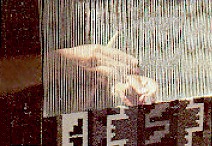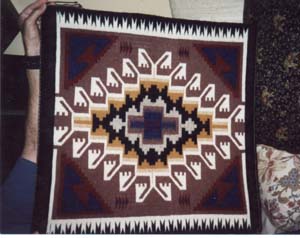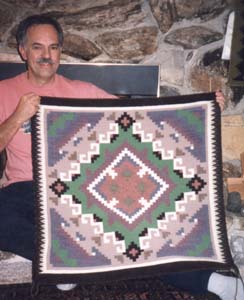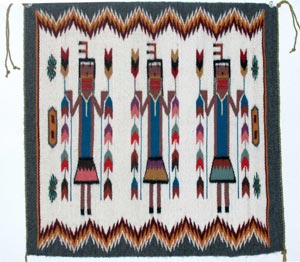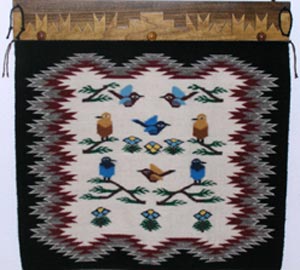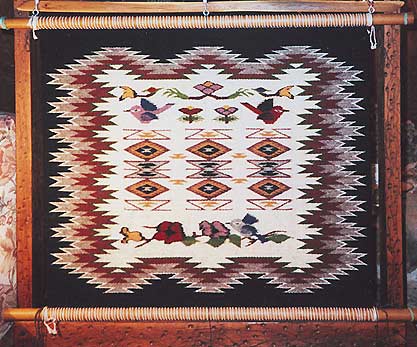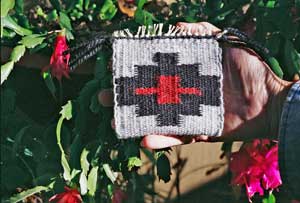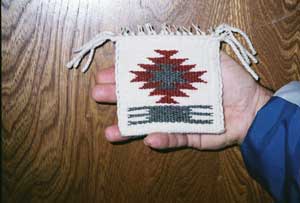|
|
|
|
Saltillo |
|
||
|
|
|
Burnt- |
|
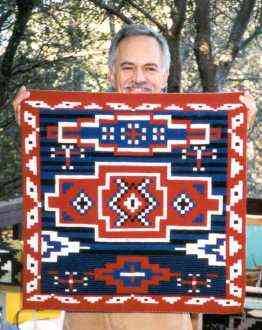 |
Two Mini Rugs |
|
|
of all the detail and interior design. |
|
 |
Burntwater, 18" X 20". I dyed the background yarn with walnut hulls, and includes a natural dyed rust color derived from Eucalyptus leaves. Another interesting experiment I included in this piece was to use various vertical joint techniques to produce a shadow effect between areas and colors. |
|
|
|
|
|
Yei style pictorial, 2003 |
pictorial about 2' square, 2003 |

FRONT VIEW |
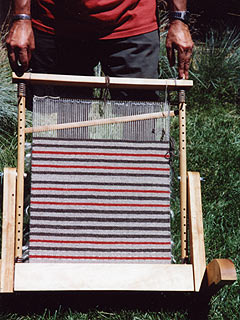 BACK VIEW |
Summer is fast approaching and I am just about finished weaving a small 18 X24 Navajo style Tufted rug as my latest effort to experience a goal of weaving the full array of Navajo traditional styles. The technique was used in the old days to make homemade mattresses. The tufted rug is an old Navajo technique which creates a sheepskin with real advantages. The process of tanning hides is difficult and often resulted in stiff skins. The advantage of weaving the goat hair into a rug base provides a pliable and soft blanket that wraps around the sleeper covering the troublesome drafty holes. We all have experienced those crisp nights sleeping in a tent at Sarah's. Ah, Ha! A full length rug like this would do the trick. Additionally, it can be rolled up and stored conveniently. Using long 6 inch or longer locks of mohair results in a shaggy rug that looks very much like a real sheepskin. If you desire to incorporate design, since the tufts are inserted individually, they can be of different colors for whatever visual effect. Tufts of wool are taken from the fleece which is washed by hand, combed out, and laid in individually, leaving the long ends hanging out. Then a few rows of tight plain weave between the rows of tufts make the rug strong. This shows through on the reverse side as short dashes of white across the back. The rug displayed consists of white angora goat tufts and the backing is worsted weight wool in gray, charcoal gray, and rust stripes. The tufting is dense enough that the design does not show through, but is displayed on the back of the rug. Edge cording was also used for strength and durability. I'll probably use it as an example for students who may wish to try to weave one, but primarily as a comfortable pad to sit on while weaving at my loom. |
|
Once I decided on a paraphrase of a border I had made before, I added more complexity and then began to fill the interior space. The inspiration was to combine pictorial elements and traditional geometric motifs, while maintaining balance and harmony. I am pleased with the result, I call "Hummingbird sipping from a flower." (See photo of detail below) |
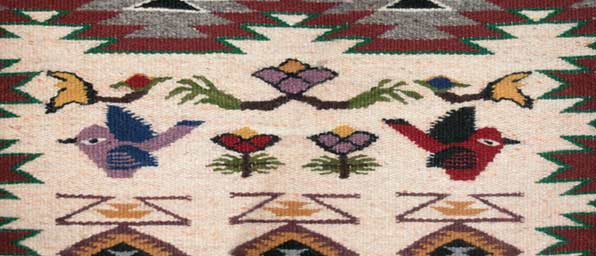 |
|
|
|
|
 |
| This is my Navajo style horse cinch. Warping it to the "D" rings is a different method than used on a traditional rug, and produces an extremely strong belt to hold the saddle on the horse. It is done in the Navajo twill weave for beauty of appearance and comfort for the animal. The twill weave, utilizing four heddles, produces a thicker, heavy belt. Examples of horse cinches are rare in books dealing with Navajo weaving, and I have never seen one for sale in the trading posts and stores I have visited in the Southwest. |
Photographs from Mel's Workshop for the Great Basin Basket Weaver's Guild
|
|
Gallery of weavings by Ashtl'o Guild members July 2009 |
